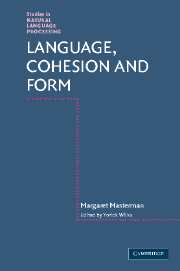Book contents
- Frontmatter
- Contents
- Preface
- Editor's introduction
- Part 1 Basic forms for language structure
- Part 2 The thesaurus as a tool for machine translation
- Part 3 Experiments in machine translation
- 6 ‘Agricola in curvo terram dimovit aratro’
- 7 Mechanical pidgin translation
- 8 Translation
- Part 4 Phrasings, breath groups and text processing
- Part 5 Metaphor, analogy and the philosophy of science
- Bibliography of the scientific works of Margaret Masterman
- Other References
- Index
6 - ‘Agricola in curvo terram dimovit aratro’
Published online by Cambridge University Press: 22 September 2009
- Frontmatter
- Contents
- Preface
- Editor's introduction
- Part 1 Basic forms for language structure
- Part 2 The thesaurus as a tool for machine translation
- Part 3 Experiments in machine translation
- 6 ‘Agricola in curvo terram dimovit aratro’
- 7 Mechanical pidgin translation
- 8 Translation
- Part 4 Phrasings, breath groups and text processing
- Part 5 Metaphor, analogy and the philosophy of science
- Bibliography of the scientific works of Margaret Masterman
- Other References
- Index
Summary
This chapter examines a first-stage translation from Latin into English with the aid of Roget's Thesaurus of a passage from Virgil's Georgics.
The essential feature of this program is the use of a thesaurus as an interlingua: the translation operations are carried out on a head language into which the input text is transformed and from which an output is obtained. The notion of ‘heads’ is taken from the concepts or topics under which Roget classified words in his thesaurus. These operations are of three kinds: semantic, syntactic and grammatical.
The general arrangement of the program is as follows:
Dictionary matching: the chunks of the input language are matched with the entries in a Latin interlingual dictionary giving the raw material of the head language; this consists of heads representing the semantic, syntactic and grammatical elements of the input.
Operations on the semantic heads: these give a first-stage translation.
Operations on the syntactic heads: giving a syntactically complete, though unparsed, translation.
Operations on the grammatical heads: giving a parsed and correctly ordered output.
Cleaning up operations: the output is ‘trimmed’ by, e.g., insertion of capital letters, removal of repetitions like ‘farmer-er’.
Only Stage 2 of the procedure is given in detail here.
Information obtained from stage 1
The Latin sentence to be translated was chunked as follows:
AGRI-COL-A IN-CURV-O TERR-AM DI-MOV-IT AR-ATRO
A number of these generated syntactic heads only. Those with semantic head entries are AGRI-COL-IN-CURV-TERR-DI-MOV-AR-.
- Type
- Chapter
- Information
- Language, Cohesion and Form , pp. 149 - 160Publisher: Cambridge University PressPrint publication year: 2005

